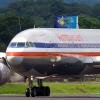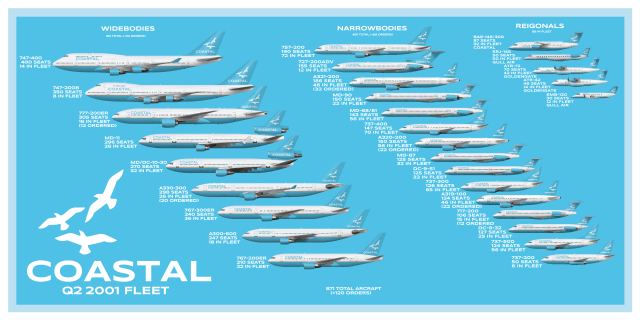
Coastal 2001 Fleet
- Owner: M31MK (View all images and albums)
- Uploaded: Apr 06 2021 05:33 PM
- Views: 1,075
- Album Coastal Airlines [OLD]
©airlithuania 2021 | Do not redistribute without written consent from airlithuania. Templates by med, N664US, Edge, Atsuk0.

Background Info:
In the early 90’s Coastal was looking into expanding its Network into the Western United States. To do so, the airline was looking to acquire mid-sized airlines that solely operated from west coast bases, as Coastal did not want to have competing hubs in the east coast. Very few airlines actually fit into this criteria, with the ones that fit not looking into a merger. But in 1995, one of these airlines, GoldenAir, was starting to move into financial troubles, due to their large orderbook and aggressive replacement strategy.
Coastal Airlines approached the struggling airline, with an offer to buy 40% of the company, in exchange for a codesharing agreement and 4 Billion Dollars to help pay for their large orderbook of Airbus and McDonnell Douglas Aircraft. GoldenAir accepted the deal.
In 1998, GoldenAir was still in a financial pit, due to the airline’s underperforming MD-11’s and aging DC-10’s. Coastal offered to buy out GoldenAir from their parent company. The offer was accepted, and the airlines went through the process of government approval. The deal was approved in late 1998.
On January 1st, 2000 Coastal and GoldenAir Were granted a single operating ticket, and all traces of the GoldenAir brand were gone by the end of the same month, with the last DC-10 being painted in the Coastal Airlines Livery.
The combined fleet was one of the largest in the world, with 871 aircraft, including the regional fleet. It was also one of the most complex in the world, with 25 different aircraft types. Coastal operated so many types as the company decided that expansion into its newly announced hubs on EWR and LAX using brand new aircraft was more important than optimizing and replacing the aging fleet.
After 9/11, the following rise in oil prices and slump in passenger demand made Coastal rethink their expansion over replacement strategy. The airline froze all expansion just 10 days after the fateful day. The airline started retiring their oldest types, and the airline cancelled all remaining MD-10 conversions.
Hubs:
The hubs of the airline at the time were MIA (Miami International Airport), BOS (Boston Logan International Airport), EWR (Newark International Airport), RDU(Raleigh-Durham International Airport), BWI (Baltimore-Washington International Airport), SFO(San Francisco International Airport), LAX (Los Angeles International Airport), SEA (Seattle International Airport) and, LAS (Las Vegas McCarran International Airport)
Please tell me if you see any mistakes
its nice, but this is WAY too many aircraft to be realistic with the lore you've written. a more realistic number would be somewhere in the 5-600 aircraft range and even that is on the large side. United has a fleet of 827 aircraft as of today after receiving more aircraft than it's retiring
I wouldn't really call this too much. Delta had fewer hubs but still had well over 900 aircraft prior to their 2005 bankruptcy. Also, I wouldn't use post-pandemic fleet numbers of the smallest legacy carrier to a just merged, growing (up until 9/11 at least) legacy carrier.
I wouldn't really call this too much. Delta had fewer hubs but still had well over 900 aircraft prior to their 2005 bankruptcy. Also, I wouldn't use post-pandemic fleet numbers of the smallest legacy carrier to a just merged, growing (up until 9/11 at least) legacy carrier.
yeah I didn't realize united was the smallest. Carry on
Not bad but personally I think that you have to many types in this fleet
Its meant to be two very different fleets combined together, with both of those fleets undergoing modernization.
I would hate to see the maintenance and crew costs for this huge fleet mixture!!!
I think, for a start, you should remove all the Airbuses bar the A300, and maybe the 777 too. I also think that for now, you should choose between the 737 and DC-9 families for your narrowbody fleet. Maybe have the DC-9 at this time, then replace them with a 737 fleet in the later years.
I think, for a start, you should remove all the Airbuses bar the A300, and maybe the 777 too. I also think that for now, you should choose between the 737 and DC-9 families for your narrowbody fleet. Maybe have the DC-9 at this time, then replace them with a 737 fleet in the later years.
Im not going to remove the 737 or the DC-9 because they originally came from two different fleets. The DC-9's from GoldenAir, and the 737 from Coastal. The A320 was originally ordered by GoldenAir in order to replace the DC-9, and later down the line, the MD-80's. The 727's were replaced by the 757 about 2 years after 2001. The reason why I included the 777 was to replace the 747-200, and actually, if you look back at my previous post is this gallery, you can see that I took out 7 747-200's. I'll give more info when I have the time.
Needless to say, the enormous amount of complexity involved in creating a US airline brand, from the lore right down to the fleet history and route operations, is one big reason why I never included one in my brand portfolio. But anyways, you're off to a good start
Woah...that's way too many aircraft types even for a big American legacy carrier. Like many others here suggested before me, consider paring down the number of aircraft types (and variants if possible). Even US Airways, which has gone through enough mergers throughout its history, has taken a good look at fleet rationalization over the course of its lifetime.
Needless to say, the enormous amount of complexity involved in creating a US airline brand, from the lore right down to the fleet history and route operations, is one big reason why I never included one in my brand portfolio. But anyways, you're off to a good start
I just lost every .psd from this post so it might already be the end. I'm still gonna try to iron out this post but after that Coastal will probably be no more.

 Sign In
Sign In Create Account
Create Account














its nice, but this is WAY too many aircraft to be realistic with the lore you've written. a more realistic number would be somewhere in the 5-600 aircraft range and even that is on the large side. United has a fleet of 827 aircraft as of today after receiving more aircraft than it's retiring